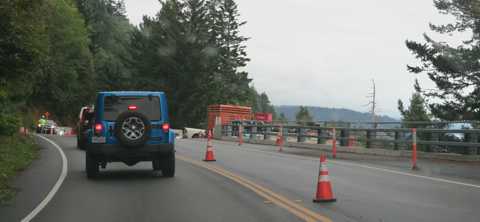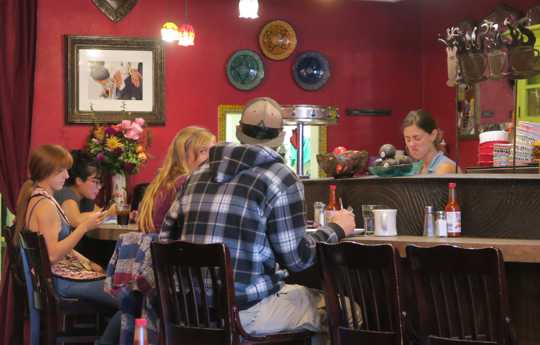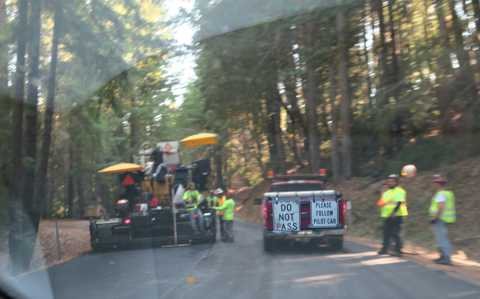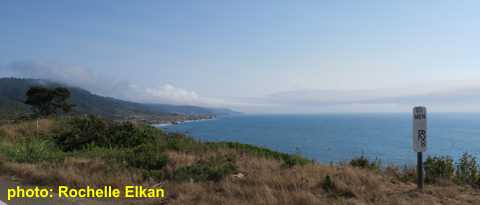| itinerary < 29 August Ashland 4 May Caspar > | to Caspar 30 August 2018 |
Home Again Jiggety JigLongest travel day of the trip, but you know what they say about horses headed back to the barn. And it's a beautiful ride. Through the Rogue and Applegate valleys, the smoke increased. Signs along the road warned of reduced visibility and fire crew activity, but the actual fires were in the Kalmiopsis Wilderness north and west of our route, and the air cleared before Cave Junction. |
 |
|
Shortly thereafter, the cheery Welcome sign ...to the fifth largest economy on the planet. The man at the Ag Inspection waved us on through; we were sorry, because, for a change, we weren't carrying contraband. |
 |
|
Took our usual 'shortcut' just short of Hiouchi along the narrow winding gravel road through Smith Redwoods State Park. Not too far from this picture, up the hill to the right, is the secret location of the tallest trees in the world. This is a magical place, and even 16 mph seems a little fast. But we're on our way home. |
 |
|
This ground under this stretch of road is constantly moving – subduction, y'know – and so expect to see flaggers and one-lane traffic. |
 |
|
One advantage to the Howland Hill Dodge (above) is that one completely misses Crescent City, not one of California's highlights. Almost immediately, Highway 101 curves and climbs through more big Redwoods, and then the view out to the Pacific breaks through the trees. |
 |
|
Past enormous lagoons, Trees of Mystery (locally known as 'Stumps of Mystery'), and across the mighty Klamath River, where the bridge is adorned with Golden Bears... |
 |
|
Another diversion: the Newton B. Drury Scenic Parkway through Prairie Creek Redwoods. This 10 mile stretch of road used to be Highway 101 – imagine it with the present traffic ...and weep! – but it got circumvented to the east by a swooping freeway in order to save these trees. Newton, in case you wondered, was a director of the National Park Service, but, more importantly, the first director of the Save the Redwoods League back when it really mattered. |
 |
|
Thank you, Newton ...and all the others who recognized the need to save this for their grandchildren. |
 |
 |
Lunch stop in Arcata at Renata's Creperie, where we indulged in the specials and enjoyed the ambiance of California's Northernmost State College town.
|
|
Back in the saddle and whizzing through the Redwoods along 'the Avenue of the Giants' ...and Giants they are, more of the tallest, oldest, biggest growing things in the world. These particular giants, along the swath cut by four lanes of freeway, aren't faring especially well, due to the added exposure to weather caused when they lost their brothers and sisters to 'progress.' |
 |
|
The Eel River waters these woods. Every so often, a view of the wide, gravelly river bed, opens up, and the highway curves across several bridges that show what an angry river this can become in the winter time. At one point along here there's a pole about 20 feet tall, and up about the 16 foot mark it shows the high water mark in the 1967 floods that wiped out the railroad connection between Eureka and the rest of the world. Here again, the hills in the distance are partially obscured by smoke from one of our many wildfires. |
 |
|
Where there's traffic, there's a market, and where there's a market, there's unattractive marketing. Better than a Big Box Store? I think so. Just try not to see the signs... |
 |
|
Through Richardson Grove State Park, Highway 101 pinches down to two narrow lanes. Between the big trees and the Eel River, there's not much room for the four lanes the traffic requires (and of course fixing the railroad never occurs to anyone.) So everyone slows down and threads their way between these majestic creatures. Just before I took this, a lumber truck with five magnificent stems rolled past. Even I am of two minds about this. Redwood trees are rare and imposing. Redwood lumber is my favorite carpentry material, and costs like gold. |
 |
|
The upper Eel is, at this time of year, a sylvan delight, with deep clear warm pools up against rocky banks, cobbled beaches and even some sand. Oh, and don't forget the occasional dead anadromous Eel floating back to sea! But look, on the right, the eroding bank. This riverine valley is the fastest eroding on the North American continent, partly due to the erosion caused by clear-cutting (mostly no longer practiced here), and other human activities, but mostly due to the fractured underpinings caused by the subduction of the Pacific Plate beneath the North American, here more active than anywhere else along the long cluster of fault lines. My father used to like to say, 'God isn't quite finished with this land yet.' |
 |
|
One last reminder not to take our smooth highways for granted: a twelve minute wait while the boyz get their pilot car turned around. During the delay, no fewer than three cars tried to bull their way past the line of patiently waiting cars. No ill wind department: we're first in line with the twisty, mountainous bit of Highway One from Leggett to Westport ahead of us, meaning that we won't have to wait for any frightened jerk from Georgia who's hauling his house on his back and is petrified by edges. |
 |
|
And then, back to our Pacific and the end run into Fort Bragg, on the point visible in the far distance in the photo at right, and then five miles to Caspar, Sienna, Pi-cat, and home. 1,974 miles. No accidents seen, and only two traffic stops. 29.6 gallons of gas, or 66.7 miles per gallon in our comfy, thrifty Prius Prime: the best car I have ever owned. |
 |
 |
updated 16 June 2023 Caspar Time site software and photographs by the Caspar Institute except as noted this site generated with 100% recycled electrons! send website feedback to the CI webster © copyright 2002-2024 Caspar Institute |